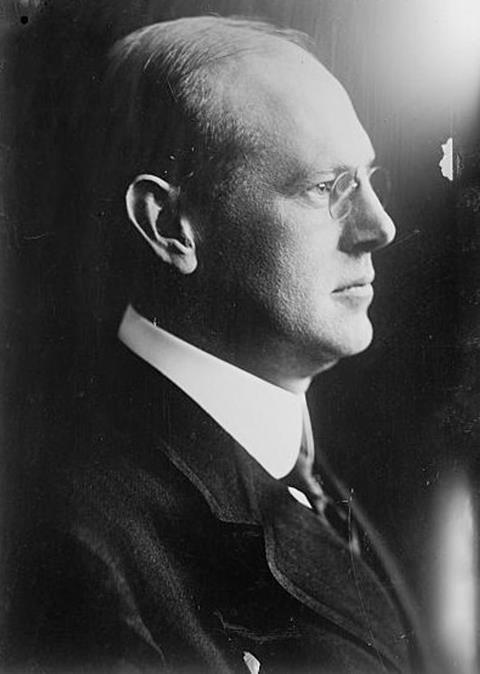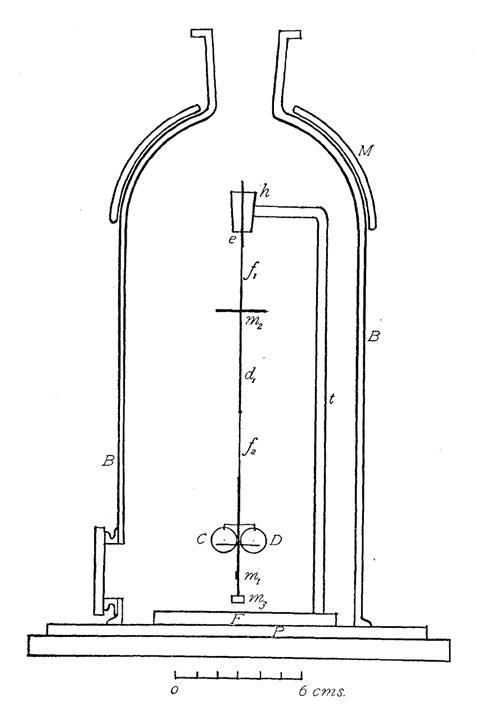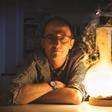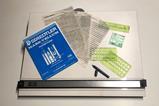A sensitive reflection of light pressure

As I write these words a comet speeds across our skies. Not that I’ve seen it – in London the stray light is so bright that such marvels are near-invisible. Johannes Kepler was the first to point out that the tail of a comet always points away from the sun, blown by the light; an idea that gained support from Isaac Newton’s corpuscular theory. In the 18th century, Leonhard Euler, a subscriber to Christiaan Huygens’ wave theory, proved that longitudinal waves too could transfer momentum to objects in their path, an idea developed by James Clerk Maxwell in 1873 when he unified electricity and magnetism. Shortly after this, Adolfo Bartoli suggested that radiation must have a pressure. It was an intriguing idea, but could it be measured?
While doing spectral experiments using infrared light William Crookes devised his spinning radiometer, an evacuated bulb with a central pin that supported a delicate propeller-like assembly of four square vanes, the two sides painted black or silvered. When exposed to light the vanes spin merrily – you can buy one as a novelty present. But as an instrument, it was useless; you can’t translate the motion into useful measurement. Worse still, the vanes rotate in the wrong direction – the absorbing black side moves towards the light. Osborne Reynolds soon showed that the motion was due to a subtle effect around the edges of the vanes, where the atoms of the thin gas in the bulb impart greater momentum to the silvered than the black side.
Such questions were a matter of intense importance as physicists, particularly in Germany, mapped out the nature of black body radiation and how it interacts with matter. In Berlin, the physicist Ernst Pringsheim, wanting to understand Crookes’ device, measured the forces on thin slivers of mica suspended on a quartz torsion fibre, with a metal pin as a counterweight. Pringsheim’s experiments fitted Reynolds’ predictions very well but left unresolved the question of radiation pressure.
It was soon after this that a recently married American professor arrived in Berlin with his wife. Ernest Fox Nichols was born in Kansas. Both his parents died when he was quite young and he was brought up by his uncle and aunt, from whom he got his middle name. Keenly interested in the issue of black body radiation and light, he slotted right into the labs in Berlin. Working with his host, Heinrich Rubens (today remembered for his multi-holed tube that uses flames to visualise pressure changes in a gas-filled tube), he built a spectrometer to study the interaction of infrared light with quartz.
While other workers were using thermopiles or bolometers as detectors, Nichols was struck by the sensitivity of Pringsheim’s torsional radiometer. With guidance from both Rubens and Pringsheim he built a spectrometer using salt lenses, a fluorite prism as the dispersing element and an improved detector. In an evacuated chamber equipped with fluorite windows, he hung a pair of half-blackened mica vanes from a quartz fibre that ended in a small mirror, which allowed him to observe any movement Poggendorf-style. Using a Geissler mercury pump Nichols could bring the pressure down into a range where the vanes swung clearly. Though less portable than a thermopile-based instrument, it was unaffected by environmental interference – it just had to be kept under vacuum permanently to remain clean and sensitive.
It was an extraordinary instrument – the detector assembly weighed a mere 7mg and gave a full-scale deflection when exposed to the light of a candle one metre away. After swapping fluorite for silver chloride in the windows, he could measure into the far infrared, revealing unexpected absorptions.
Going the distance
Eventually Nichols and his family – he now had a daughter too – had to return to the US. Within months he had been ‘called’ to take up a chair at Dartmouth College. Armed with a modified version of his radiometer he began to make observations at the Yerkes observatory. His new device could detect energy from the equivalent of a candle 50,000km away and with it he made detailed measurements of the heat emanating from stars and planets.

He now returned to an idea that he had had throughout his time in Berlin: the measurement of light pressure. He developed a new torsion balance with his colleague Gordon Hull. They reasoned that the sensitivity would be doubled if the light was reflected rather than absorbed, so the much larger vanes, half an inch across, were brightly silvered on one side. Crucially, while the effect of a gas should increase with time, momentum transfer from photons would be immediate. With magnetic damping and careful control of the pressure their exquisitely sensitive radiometer soon showed results exactly in line with Maxwell’s predictions and, of course, with the new particulate quantum theory.
Nichols would move multiple times, to Columbia, Yale, and back to Dartmouth as president, but never again get the time to do any science as beautiful. And it occurs to me that I’ve only seen one comet in my life – comet Kohoutec in the winter of 1973, just after sunset with a long streaming tail. Maybe I should pack a telescope into my panniers, pedal out into the darkness and marvel both at it and at Nichols’ swinging mica vanes.
Acknowledgment
John Hudson drew my attention to this device, and much more.
References
E F Nichols and G F Hull, Phys. Rev., 1901, 13, 307 (DOI: 10.1103/PhysRevSeriesI.13.307)
E F Nichols and G F Hull, Phys. Rev., 1901, 17, 26 (DOI: 10.1103/PhysRevSeriesI.17.26)

















2 readers' comments